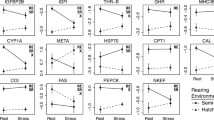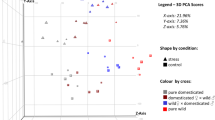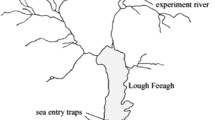Abstract
Oxidative stress (OS) may pose important physiological constraints on individuals, affecting trade-offs between growth and reproduction or ageing and survival. Despite such evolutionary and ecological importance, the results from studies on the magnitude of individual variation in OS resistance and the underlying causes of this variation such as genetic, environmental, and maternal origins, remain inconclusive. Using a high throughput methodology, we investigated the activity levels in three OS resistance-related enzymes (superoxide dismutase, SOD; glutathione reductase, GR; glutathione S-transferase, GST) during the early life stages of 1000 individuals from 50 paternal half-sib families in two populations of Atlantic salmon. Using animal mixed models, we detected the presence of narrow-sense heritability for SOD and GST; that for GST differed between populations due to differences in environmental variance. We found support for the presence of common environmental variation, including maternal effects, for only GR. Using a bivariate animal model, we detected a positive environmental correlation between activity levels of SOD and GST but were unable to detect an additive genetic correlation. Our results complement previous heritability findings for levels of reactive oxygen species or OS resistance by demonstrating the presence of heritability for OS-related enzyme activities. Our findings provide a foundation for future work, such as investigations on the evolutionary importance of variation in enzyme activities. In addition, our findings emphasise the importance of accounting for developmental stage, environmental variance, and kin relationships when investigating the OS-response at the enzyme activity level.


Similar content being viewed by others
References
Alonso-Alvarez, C., Bertrand, S., Devevey, G., Prost, J., Faivre, B., & Sorci, G. (2004). Increased susceptibility to oxidative stress as a proximate cost of reproduction. Ecology Letters, 7(5), 363–368.
Beacham, T. D., & Murray, C. B. (1985). Effect of female size, egg size, and water temperature on developmental biology of chum salmon (Oncorhynchus keta) from the Nitinat River, British Columbia. Canadian Journal of Fisheries and Aquatic Sciences, 42(11), 1755–1765.
Benjamini, Y., & Hochberg, Y. (1995). Controlling the false discovery rate: A practical and powerful approach to multiple testing. Journal of the Royal Statistical Society Series B-Methodological, 57(1), 289–300.
Bize, P., Devevey, G., Monaghan, P., Doligez, B., & Christe, P. (2008). Fecundity and survival in relation to resistance to oxidative stress in a free-living bird. Ecology, 89(9), 2584–2593.
Butler DG, Cullis BR, Gilmour AR, Gogel BJ. (2009). Mixed models for S language environments ASReml-R reference manual. Brisbane: Queensland Department of Primary Industries and Fisheries, NSW Department of Primary Industries.
Carney Almroth, B., Johansson, A., Forlin, L., & Sturve, J. (2010). Early-age changes in oxidative stress in brown trout, Salmo trutta. Comparative Biochemistry and Physiology Part B, Biochemistry and Molecular Biology, 155(4), 442–448.
Costantini, D., & Dell’Omo, G. (2006). Environmental and genetic components of oxidative stress in wild kestrel nestlings (Falco tinnunculus). Journal of Comparative Physiology B, 176(6), 575–579.
Costantini, D., Monaghan, P., & Metcalfe, N. B. (2013). Loss of integration is associated with reduced resistance to oxidative stress. Journal of Experimental Biology, 216(12), 2213–2220.
Dennery, P. A. (2010). Oxidative stress in development: Nature or nurture? Free Radical Biology and Medicine, 49(7), 1147–1151.
Einum, S. (2003). Atlantic salmon growth in strongly food-limited environments: Effects of egg size and paternal phenotype? Environmental Biology of Fishes, 67(3), 263–268.
Falconer, D. S., & Mackay, T. F. C. (1996). Introduction to quantitative genetics (p. 464). Harlow: Longman. xv.
Finkel, T., & Holbrook, N. J. (2000). Oxidants, oxidative stress and the biology of ageing. Nature, 408(6809), 239–247.
Habig, W. H., Pabst, M. J., & Jakoby, W. B. (1974). Glutathione S-transferases. The first enzymatic step in mercapturic acid formation. Journal of Biological Chemistry, 249(22), 7130–7139.
Halliwell, B., & Gutteridge, J. (2007). Free radicals in biology and medicine. Oxford: Oxford University Press.
Heinimaa, S., & Heinimaa, P. (2004). Effect of the female size on egg quality and fecundity of the wild Atlantic salmon in the sub-arctic River Teno. Boreal Environment Research, 9(1), 55–62.
Hõrak, P., & Cohen, A. (2010). How to measure oxidative stress in an ecological context: Methodological and statistical issues. Functional Ecology, 24(5), 960–970.
Isaksson, C., Sheldon, B. C., & Uller, T. (2011). The challenges of integrating oxidative stress into life-history biology. BioScience, 61(3), 194–202.
Jones, D. P. (2006). Redefining oxidative stress. Antioxidants & Redox Signaling, 8(9–10), 1865–1879.
Jones, A. G., Small, C. M., Paczolt, K. A., & Ratterman, N. L. (2010). A practical guide to methods of parentage analysis. Molecular Ecology Resources, 10(1), 6–30.
Kamler, E. (2002). Ontogeny of yolk-feeding fish: An ecological perspective. Reviews in Fish Biology and Fisheries, 12(1), 79–103.
Kamler, E. (2005). Parent–egg–progeny relationships in teleost fishes: An energetics perspective. Reviews in Fish Biology and Fisheries, 15(4), 399–421.
Kamler, E. (2008). Resource allocation in yolk-feeding fish. Reviews in Fish Biology and Fisheries, 18(2), 143–200.
Kane, T. R. (1988). Relationship of temperature and time of initial feeding of Atlantic salmon. Progressive Fish-Culturist, 50(2), 93–97.
Kaplan, R. H. (1987). Developmental plasticity and maternal effects of reproductive characteristics in the frog, Bombina orientalis. Oecologia, 71(2), 273–279.
Kenward, M. G., & Roger, J. H. (1997). Small sample inference for fixed effects from restricted maximum likelihood. Biometrics, 53(3), 983–997.
Kim, S.-Y., Noguera, J. C., Morales, J., & Velando, A. (2010a). Heritability of resistance to oxidative stress in early life. Journal of Evolutionary Biology, 23(4), 769–775.
Kim, S. Y., Velando, A., Sorci, G., & Alonso-Alvarez, C. (2010b). Genetic correlation between resistance to oxidative stress and reproductive life span in a bird species. Evolution, 64(3), 852–857.
Kruuk, L. E., & Hadfield, J. D. (2007). How to separate genetic and environmental causes of similarity between relatives. Journal of Evolutionary Biology, 20(5), 1890–1903.
Limon-Pacheco, J., & Gonsebatt, M. E. (2009). The role of antioxidants and antioxidant-related enzymes in protective responses to environmentally induced oxidative stress. Mutation Research, 674(1–2), 137–147.
Livingstone, D. R. (2001). Contaminant-stimulated reactive oxygen species production and oxidative damage in aquatic organisms. Marine Pollution Bulletin, 42(8), 656–666.
Losdat, S., Helfenstein, F., Blount, J. D., & Richner, H. (2014). Resistance to oxidative stress shows low heritability and high common environmental variance in a wild bird. Journal of Evolutionary Biology, 27(9), 1990–2000.
Lundström, J., Carney, B., Amcoff, P., Pettersson, A., Börjeson, H., Förlin, L., & Norrgren, L. (1999). Antioxidative systems, detoxifying enzymes and thiamine levels in Baltic salmon (Salmo salar) that develop M74. Ambio, 28(1), 24–29.
Mari, M., Morales, A., Colell, A., Garcia-Ruiz, C., & Fernandez-Checa, J. C. (2009). Mitochondrial glutathione, a key survival antioxidant. Antioxidants & Redox Signaling, 11(11), 2685–2700.
Metcalfe, N. B., & Alonso-Alvarez, C. (2010). Oxidative stress as a life-history constraint: The role of reactive oxygen species in shaping phenotypes from conception to death. Functional Ecology, 24(5), 984–996.
Monaghan, P., Metcalfe, N. B., & Torres, R. (2009). Oxidative stress as a mediator of life history trade-offs: Mechanisms, measurements and interpretation. Ecology Letters, 12(1), 75–92.
Noguera, J. C., Lores, M., Alonso-Álvarez, C., & Velando, A. (2011). Thrifty development: Early-life diet restriction reduces oxidative damage during later growth. Functional Ecology, 25(5), 1144–1153.
Olsson, M., Wilson, M., Uller, T., Mott, B., Isaksson, C., Healey, M., & Wanger, T. (2008). Free radicals run in lizard families. Biology Letters, 4(2), 186–188.
Pamplona, R., & Costantini, D. (2011a). Molecular and structural antioxidant defenses against oxidative stress in animals. American Journal of Physiology - Regulatory, Integrative and Comparative Physiology, 301, R843–R863.
Pamplona, R., & Costantini, D. (2011b). Molecular and structural antioxidant defenses against oxidative stress in animals. American Journal of Physiology - Regulatory, Integrative and Comparative Physiology, 301(4), R843–R863.
R Core Team. (2013). R: A language and environment for statistical computing. Vienna, Austria ISBN: 3-900051-07-0: R Foundation for Statistical Computing.
Rizzo, A. M., Adorni, L., Montorfano, G., Rossi, F., & Berra, B. (2007). Antioxidant metabolism of Xenopus laevis embryos during the first days of development. Comparative Biochemistry and Physiology Part B: Biochemistry and Molecular Biology, 146(1), 94–100.
Rubolini, D., Romano, M., Bonisoli Alquati, A., & Saino, N. (2006). Early maternal, genetic and environmental components of antioxidant protection, morphology and immunity of yellow-legged gull (Larus michahellis) chicks. Journal of Evolutionary Biology, 19(5), 1571–1584.
Schneider, C. A., Rasband, W. S., & Eliceiri, K. W. (2012). NIH Image to ImageJ: 25 years of image analysis. Nature Methods, 9(7), 671–675.
Smith, I. K., Vierheller, T. L., & Thorne, C. A. (1988). Assay of glutathione reductase in crude tissue homogenates using 5,5′-dithiobis(2-nitrobenzoic acid). Analytical Biochemistry, 175(2), 408–413.
Timme-Laragy, A. R., Goldstone, J. V., Imhoff, B. R., Stegeman, J. J., Hahn, M. E., & Hansen, J. M. (2013). Glutathione redox dynamics and expression of glutathione-related genes in the developing embryo. Free Radical Biology and Medicine, 65, 89–101.
Tvenning, H. (1985). Fiskeoppdrett. Oslo: H. Aschehoug & Co.
Ukeda, H., Kawana, D., Maeda, S., & Sawamura, M. (1999). Spectrophotometric assay for superoxide dismutase based on the reduction of highly water-soluble tetrazolium salts by xanthine-xanthine oxidase. Bioscience, Biotechnology, and Biochemistry, 63(3), 485–488.
van der Leeden R, Busing FM, Meijer E. (1997). Bootstrap methods for two-level models. In Multilevel conference (p. 26). Amsterdam, Netherlands.
Vuori, K. A. M., & Nikinmaa, M. (2007). M74 syndrome in Baltic salmon and the possible role of oxidative stresses in its development: Present knowledge and perspectives for future studies. AMBIO: A Journal of the Human Environment, 36(2), 168–172.
Wilson, A. J., Reale, D., Clements, M. N., Morrissey, M. M., Postma, E., Walling, C. A., et al. (2010). An ecologist’s guide to the animal model. Journal of Animal Ecology, 79(1), 13–26.
Wolak, M. E. (2012). nadiv: An R package to create relatedness matrices for estimating non-additive genetic variances in animal models. Methods in Ecology and Evolution, 3(5), 792–796.
Acknowledgments
We thank the Põlula Fish Rearing Centre for creating and maintaining animals and logistic support; L. Maran, L. Pukk, K. Pai, I. Tallerman and M. Aid for hatchery assistance; T. Pajula, PM. Maravi, N. Vuori, M. Kanerva and K. Sõstar for laboratory assistance. For initial analyses and manuscript improvements we greatly thank M. Bruneaux. Sylvain Losdat and three anonymous reviewers are thanked for improving an earlier version of the manuscript. This study was funded by the SA Archimedes Foundation, Emil Aaltosen Säätiö and Oskar Öflunds Stiftelse to SK, the Estonian Science Foundation (Grant Numbers 6802, 8215) and the Estonian Ministry of Education and Research (institutional research funding project IUT8-2) to AV and the Academy of Finland to AV, J-PV and KV.
Author information
Authors and Affiliations
Corresponding author
Ethics declarations
Conflict of interest
The authors declare that they have no conflict of interest.
Additional information
Siim Kahar and Paul V. Debes have contributed equally to this work.
Electronic supplementary material
Below is the link to the electronic supplementary material.
Rights and permissions
About this article
Cite this article
Kahar, S., Debes, P.V., Vuori, K.A.M. et al. Heritability, Environmental Effects, and Genetic and Phenotypic Correlations of Oxidative Stress Resistance-Related Enzyme Activities During Early Life Stages in Atlantic Salmon. Evol Biol 43, 215–226 (2016). https://doi.org/10.1007/s11692-016-9368-5
Received:
Accepted:
Published:
Issue Date:
DOI: https://doi.org/10.1007/s11692-016-9368-5




